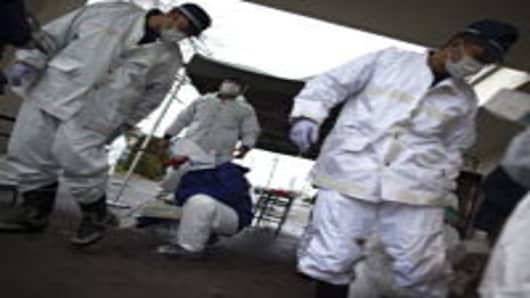Two nuclear plant workers have exceeded Japan's radiation exposure limit for men, and others who toiled without sufficient protection in the earliest days of the crisis could show high levels as well, the government and plant operator said Friday.
The two control room operators are the first men to surpass the government-set limit. About 40 workers are being tested further after preliminary findings showed high exposures, TEPCO spokesman Junichi Matsumoto said.
The two men are not showing immediate health problems. Matsumoto quoted unidentified doctors at the National Institute of Radiological Sciences who examined them and said the two men don't require current health treatment and can live normally.
They will need long-term health monitoring, and TEPCO will take care of those checks due to a increased risk of developing cancer, he said.
Workers have been fighting to get the Fukushima Dai-ichi plant under control since the March 11 earthquake and tsunami knocked out power and crucial cooling systems, largely melting the cores of three reactors. Several explosions have scattered highly radioactive debris around the plant and radiactivity has leaked into the environment around it.
The two men, one in his 30s and another in his 40s, were responsible for the central control room for Unit 3 and 4 reactors the day the disasters struck and in the days that followed. About 150 other control room operators worked early in the crisis and are being examined.
"Monitoring of internal exposures has been slow. I'm afraid we'll see more people exceeding 250 millisieverts," Goshi Hosono, director of the government's crisis management taskforce, urging TEPCO to speed up monitoring of workers' health and take appopriate steps.
The government had raised the limit for men to 250 millisieverts from the earlier 100 millisieverts to tackle the crisis soon after the earthquake and tsunami struck.
Total exposures of the two workers may be as high as 580 millisieverts -- nearly 1,000 abdominal X rays -- if they were almost entirely irradiated in the first two days, when a first explosion occurred at the plant, Matsumoto said. The total exposure would depend on whether they wore masks, where they were inside the facility and other factors.
Officials are still examining details to finalize the results. A massive single whole-body exposure of 500 millisieverts could decrease lymphocyte cells in some people, which would compromise their immune systems.
TEPCO has been criticized for not fully disclosing the extent of radiation exposures by the plant workers or their working conditions.
Concerns about workers' health risks surged this week when TEPCO revealed preliminary tests on the two workers. The health ministry then ordered TEPCO to check internal exposure levels of all workers who have worked closely with the two men and to remove them from plant duties.
Matsumoto said workers most likely inhaled radioactive particles while battling the initial crisis without sufficiently covering themselves with masks and radiation-proof gear.
TEPCO has promised to bring the plant under control by January, but fears are growing that was too optimistic.


